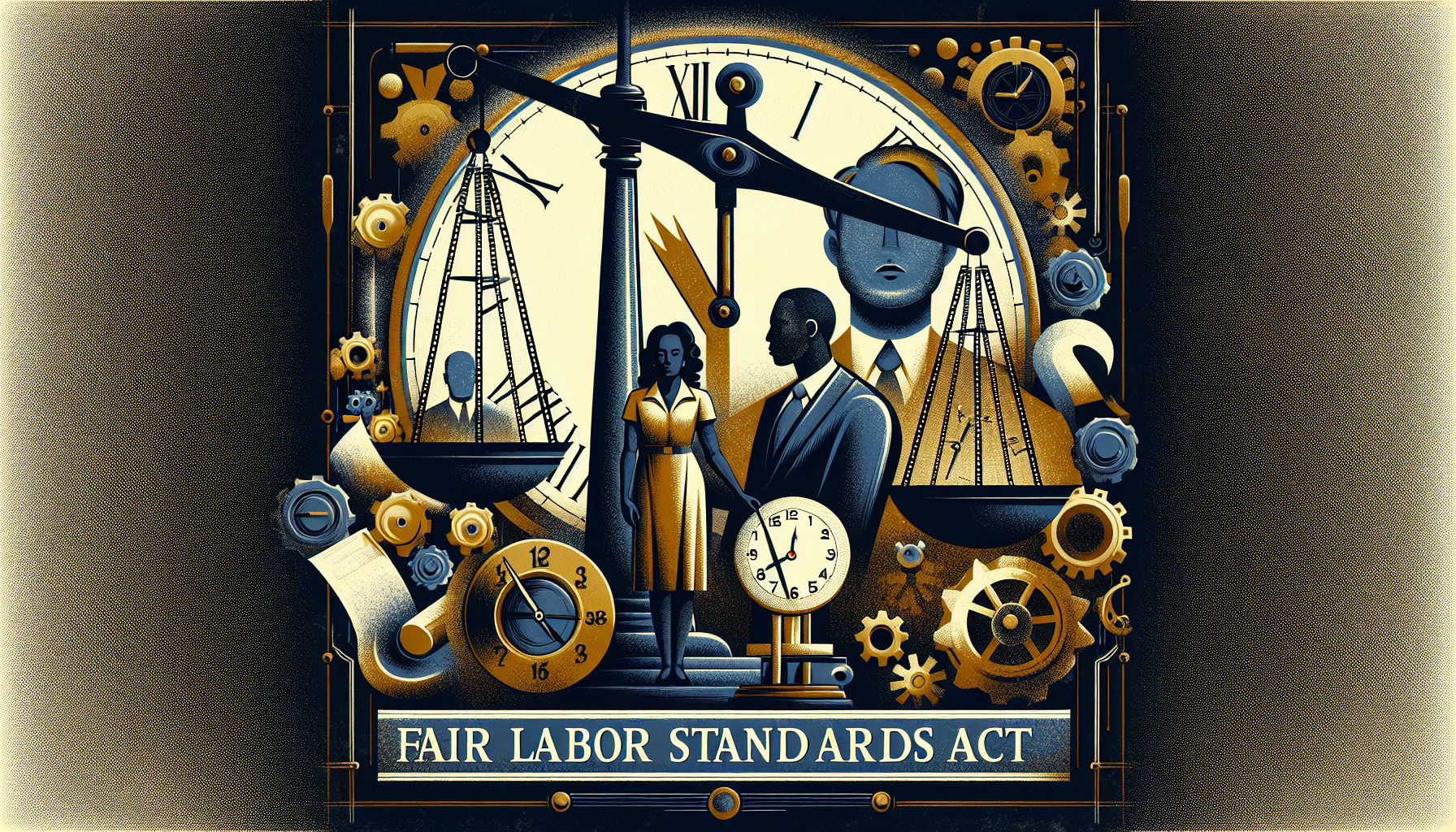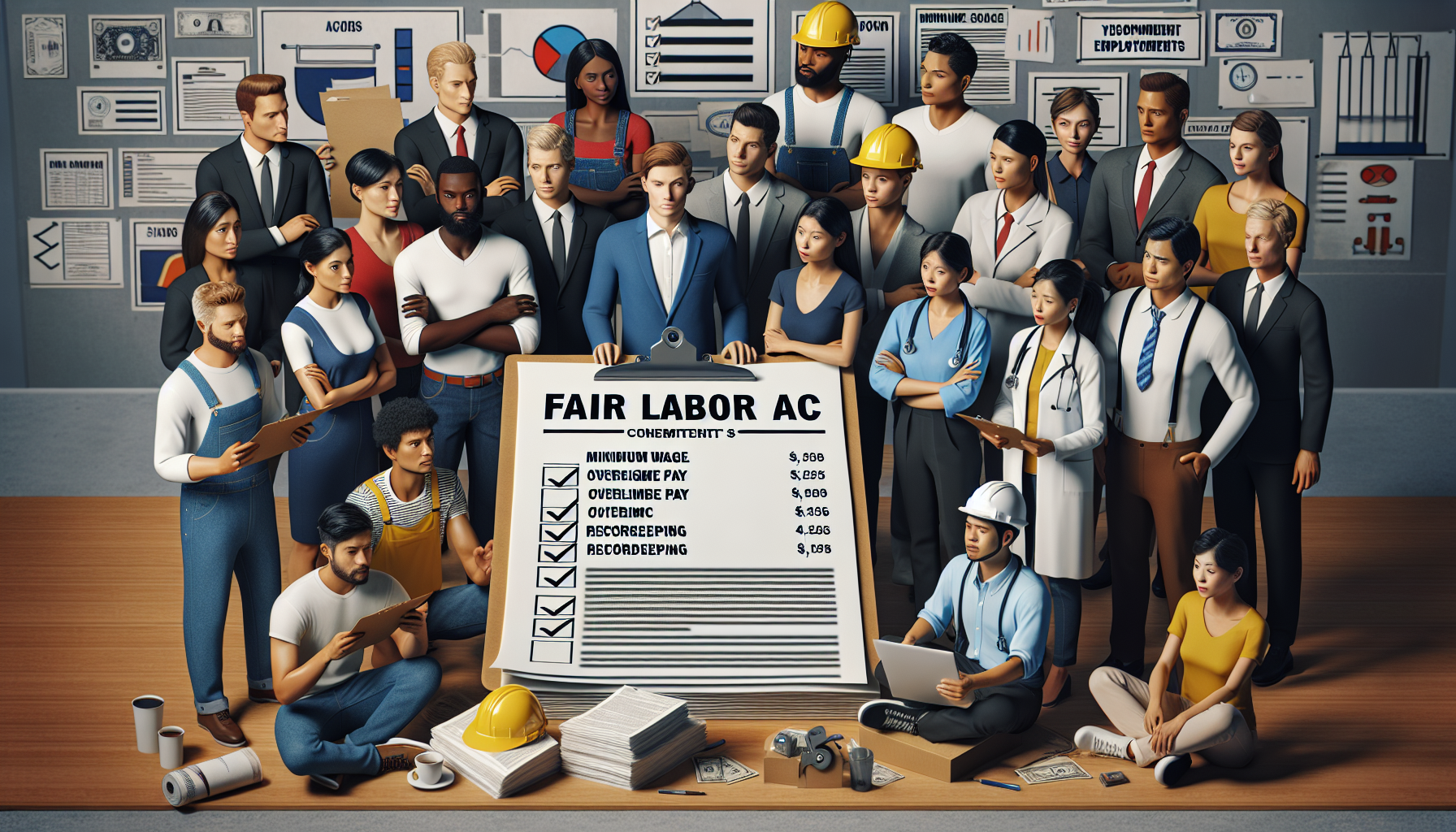The 1938 Fair Labor Standards Act (FLSA): Safeguarding
the American Worker and Shaping the Modern Workplace - Sample Policy Below

The American workplace, a dynamic environment of innovation, productivity, and economic growth, is underpinned by a complex framework of laws designed to protect its most valuable asset: its workers. Among these laws, the 1938 Fair Labor Standards Act (FLSA) stands as a cornerstone, a piece of legislation that has profoundly shaped the landscape of employment in the United States. Enacted in 1938, the FLSA addresses fundamental labor concerns, ensuring fair wages, regulating working hours, and safeguarding the well-being of child laborers. This article will delve into the intricacies of the FLSA, exploring its key provisions and examining its enduring impact on the American worker.
The Genesis of the 1938 Fair Labor Standards Act (FLSA):
Addressing Labor Exploitation

The Great Depression exposed the harsh realities of unregulated labor practices. Rampant unemployment led to a race to the bottom, with businesses slashing wages and demanding long hours to stay afloat. Child labor was widespread, often under grueling conditions that deprived young people of their education and health. It was against this backdrop of economic hardship and worker exploitation that President Franklin D. Roosevelt championed the passage of the 1938 Fair Labor Standards Act.
The FLSA was a direct response to these injustices. It aimed to establish a baseline of fairness in the workplace, ensuring that workers received a minimum wage, were compensated for overtime work, and were protected from exploitative child labor practices. The Act marked a significant shift in the federal government's role in regulating the employer-employee relationship, setting a precedent for future labor legislation.
Key Provisions of the FLSA: Protecting Workers' Rights

The FLSA encompasses several core provisions that directly impact the American worker:
Minimum Wage: The FLSA establishes a federal minimum wage, a floor below which hourly wages cannot fall. This provision aims to ensure that workers receive a minimum level of compensation sufficient to maintain a basic standard of living. The federal minimum wage has been adjusted periodically since its inception, reflecting changes in the cost of living and economic conditions. While states are permitted to set their own minimum wages, they must be at least as high as the federal minimum wage.
Overtime Pay: Recognizing the potential for worker exploitation through excessive hours, the FLSA mandates overtime pay for employees who work more than 40 hours in a workweek. Overtime pay is typically calculated at one and a half times the employee's regular rate of pay. This provision encourages employers to manage workloads effectively and compensate employees fairly for the additional time they dedicate to their jobs.
Child Labor Restrictions: The FLSA places strict limitations on the employment of children, aiming to protect their well-being and ensure their access to education. The Act sets minimum age requirements for different types of work and restricts the hours and types of jobs that minors can perform. These restrictions are designed to prevent children from being exploited in dangerous or harmful occupations and to allow them to focus on their education and development.
Recordkeeping Requirements: To ensure compliance with the FLSA, employers are required to maintain accurate records of employee hours, wages, and other relevant information. These records allow the Department of Labor (DOL) to investigate potential violations of the Act and to verify that employees are being paid in accordance with the law.
Exemptions to the FLSA: Navigating the Complexities
While the FLSA provides broad protections for American workers, certain categories of employees are exempt from some or all of its provisions. These exemptions typically apply to workers in professional, administrative, executive, and outside sales roles, often referred to as "white-collar" exemptions. To qualify for an exemption, employees must meet specific criteria related to their job duties, responsibilities, and salary levels.
The determination of whether an employee is exempt from the FLSA can be complex and often requires careful analysis of the employee's specific job duties and responsibilities. Employers must ensure that they correctly classify their employees to avoid potential violations of the Act. Misclassifying an employee as exempt can result in significant financial penalties and legal liabilities.
The Impact of the FLSA on the American Worker: A Lasting
Legacy
The 1938 Fair Labor Standards Act has had a profound and lasting impact on the American worker. It has raised the standard of living for millions of low-wage workers by establishing a minimum wage and requiring overtime pay. It has protected children from exploitative labor practices, allowing them to pursue their education and develop their full potential.
The FLSA has also shaped the modern workplace by encouraging employers to manage workloads effectively and to compensate employees fairly for their time. It has fostered a culture of compliance and accountability, ensuring that employers adhere to basic labor standards.
Challenges and Ongoing Debates: Adapting to the Modern
Economy
Despite its significant achievements, the FLSA faces ongoing challenges in adapting to the evolving nature of the modern economy. The rise of the gig economy, with its increasing reliance on independent contractors and freelance workers, has raised questions about the applicability of the FLSA to these new forms of employment. The debate over raising the minimum wage continues, with advocates arguing that it is necessary to keep pace with the rising cost of living, while opponent’s express concerns about the potential impact on businesses and employment levels.
Another challenge is the increasing complexity of the FLSA regulations and interpretations. Employers often struggle to navigate the nuances of the Act, particularly in determining whether employees are exempt from its provisions. The Department of Labor continues to issue guidance and regulations to clarify the FLSA and to address emerging issues in the workplace.
Enforcement and Compliance: Ensuring Worker Protections
The Department of Labor's Wage and Hour Division (WHD) is responsible for enforcing the FLSA. The WHD conducts investigations of employers to ensure compliance with the Act, responds to complaints from workers who believe their rights have been violated, and provides education and outreach to employers and employees.
Employers who violate the FLSA can face significant penalties, including back wage payments, fines, and legal action. Employees who believe their rights have been violated under the FLSA have the right to file a complaint with the WHD or to pursue legal action on their own behalf.
Conclusion: A Continuing Commitment to Fair Labor
Standards
The 1938 Fair Labor Standards Act remains a vital piece of legislation that protects the rights and well-being of American workers. While the Act faces ongoing challenges in adapting to the changing nature of the economy, its core principles of fair wages, reasonable working hours, and protection against child labor remain as relevant today as they were when it was enacted in 1938. As the American workplace continues to evolve, it is essential to maintain a strong commitment to the principles of the FLSA, ensuring that all workers are treated fairly and have the opportunity to thrive. The ongoing dialogue and adaptation of the FLSA are crucial to maintaining its relevance and effectiveness in safeguarding the American worker in the years to come.

Sample Working Hours and Workweek Policy
A work hour is any hour of the day in which an employee has worked and should be recorded to the nearest tenth of an hour (6 minutes equals’ one tenth). The workday is defined as the 24-hour period starting at 12:00 a.m. and ending at 11:59 p.m. The workweek covers seven consecutive days beginning on Sunday at 12:00 am and ending on Saturday at 12:00 am. The usual workweek period is 40 hours. Hours worked during any workday will fall into the day that a majority of the hours worked fell into. As an example, if an employee began working at 11:00 pm on Monday and ended at 7:30 am on Tuesday the total hours worked during that shift/workday would be counted on Tuesday. Authorized overtime will be paid in accordance with state and federal law.